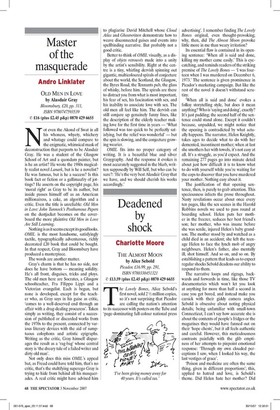Master of the masquerade
Andro Linklater OLD MEN IN LOVE by Alasdair Gray Bloomsbury, £20, pp. 311, ISBN 9780747593539 £16 (plus £2.45 p&p) 0870 429 6655 Not even the Akond of Swat in all his whoness, whyety, whichery and whatage could compare to the enigmatic, whimsical mask of deconstruction that purports to be Alasdair Gray. He was a student of the Glasgow School of Art and a quondam painter, but is he an artist? He wrote the 1980s magically realist novel Lanark, but is he a novelist? He was famous, but is he a success? Is this book fact or fiction or a gallimaufry of jottings? He asserts on the copyright page, his 'moral right' as Gray to be its author, but inside passes himself off as an American millionairess, a cake, an algorithm and a critic. Even the title is unreliable: Old Men in Love: John Tunnock's Posthumous Papers on the dustjacket becomes on the coverboard the more plaintive Old Men in Love Are Still Learning.
Nothing is as it seems except its good looks. OMIL is the most handsome, satisfyingly tactile, typographically adventurous, richly decorated £20 book that could be bought. In that respect, Gray and Bloomsbury have produced a masterpiece.
The words are another matter.
Gray's charm is that he has no side, nor does he have bottom — meaning solidity. He's all front, disguises, tricks and ploys. The old men here are Socrates, a Glasgow schoolteacher, Fra Filippo Lippi and a Victorian evangelist. Each is begun, but none is developed, except for the teacher who, as Gray says in his guise as critic, 'comes to a well-deserved end through an affair with a drug-dealing procuress'. Taken simply as writing, they consist of a succession of published or discarded works from the 1970s to the present, connected by various literary devices with the aid of sumptuous colophons and artistic epigraphs. Writing as the critic, Gray himself disparages the result as a `rag-bag' whose central story is 'the dreary tale of a failed writer and dirty old man'.
Not only does this miss OMIL's appeal but, as Freud could have told him, that's no critic, that's the stultifying superego Gray is trying to hide from behind all his masquerades. A real critic might have advised him to plagiarise David Mitchell whose Cloud Atlas and Ghostwritten demonstrate how to weave disconnected guises and events into spellbinding narrative. But probably not a good critic.
Better to think of OMIL visually, as a display of objets retrouves made into a unity by the artist's sensibility. Right at the centre is a tiny, whirling dervish spinning out gigantic, multicoloured spirals of conjecture about the world, the Scotland, the Glasgow, the Byres Road, the Tennants pub, the glass of whisky, before him The spirals are there to distract you from what is most important, his fear of sex, his fascination with sex, and his inability to associate love with sex. The old men all feel like him The dervish can still conjure up genuinely funny lines, like the description of the elderly teacher making love for the first time in years — 'What followed was too quick to be perfectly satisfying, but the relief was wonderful' — but the spin is slowing, and the conjecture growing wearier.
OMIL fits into no proper category of writing. It is a beautiful blue and silver Graygraphy. And the response it evokes is most accurately suggested in the blurb, written supposedly by Will Self, but who can be sure?: 'He's the very best Alasdair Gray that we have, and we should cherish his works accordingly.'












































































 Previous page
Previous page